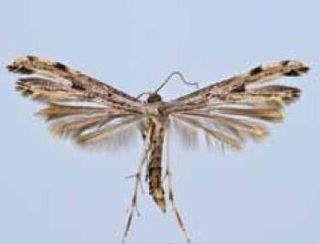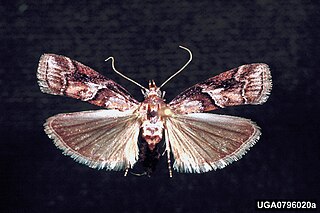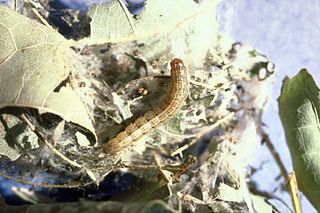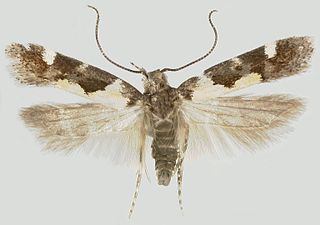Langessa is a genus of moths of the family Crambidae. It contains only one species, Langessa nomophilalis, the black langessa moth, which is found in North America, where it has been recorded from Alabama, Florida and South Carolina.

Niphograpta is a genus of moths of the family Crambidae. It contains only one species, the water hyacinth moth. It is native to the Amazon basin, but has been introduced in North America, Africa and Australia to control the spread of water hyacinth.
Strepsicrates smithiana, the bayberry leaftier moth or Smith's strepsicrates moth, is a moth of the family Tortricidae. It was first described by Lord Walsingham in 1891. It is native to southern North America, south to South America, including Florida, Texas, Georgia, Dominican Republic, Puerto Rico, Cuba and the Galapagos Islands. It was introduced to Oahu, Hawaii, in 1955 to aid in the control of Myrica faya.

Tebenna gnaphaliella, the everlasting tebenna moth, is a moth of the family Choreutidae. It is found from Florida to California and north at least to New Hampshire.

Nomophila nearctica, the lucerne moth, clover nomophila, false webworm, celery stalkworm or American celery webworm, is a moth of the family Crambidae. It is known from southern Canada and all of the United States, south to Mexico and the Neotropics.

The variable sallow moth is a moth of the family Noctuidae. It is found from Connecticut to Florida and west to Missouri and Texas.

Adaina ambrosiae is a moth of the family Pterophoridae. It is found in North America from California east to Florida and north to Ontario. It is also known from Bermuda, Costa Rica, Jamaica, Puerto Rico and the Virgin Islands.

Dioryctria zimmermani, the Zimmerman pine moth, is a moth of the family Pyralidae. It is found from southern Canada and the north-eastern and Great Lakes areas of the United States. There is a disjunct population in eastern Nebraska.

Dioryctria clarioralis, the blister coneworm moth, is a moth of the family Pyralidae. It is found in the eastern United States, including Florida, New Jersey and Virginia.

Diaphania hyalinata, the melonworm moth, is a moth of the family Crambidae. It is found in eastern North America, south to Central and South America, including Suriname and the Caribbean.

Pococera asperatella, the maple webworm moth, is a moth of the family Pyralidae. It is found in North America, including Alabama, Illinois, Massachusetts, Minnesota, New Hampshire, New Jersey, North Carolina, Oklahoma, Ontario, Pennsylvania, South Carolina, Tennessee, Texas, Virginia and Wisconsin.

Paraclemensia acerifoliella, the maple leafcutter moth, is a moth of the family Incurvariidae. It is found from south-eastern Canada and the north-eastern United States, south to the tip of the Appalachian Mountains in western North Carolina and possibly north-western Georgia.

Stegasta bosqueella is a species of moth of the family Gelechiidae. It is found in North America, including Alabama, Florida, Georgia, Illinois, Iowa, North Carolina, Oklahoma, South Carolina, Texas and Virginia.

Diatraea crambidoides, the southern cornstalk borer moth, is a species of moth of the family Crambidae described by Augustus Radcliffe Grote in 1880. It is found in North America, from Alabama and northern Florida to Ohio and Maryland. Its wingspan is 15–40 mm.

Dioryctria albovittella, the pinyon tip moth, is a species of moth of the family Pyralidae. It is found in North America including New Mexico.

Dioryctria ebeli, the south coastal coneworm moth, is a species of moth of the family Pyralidae. It is found in the US states of Florida, the southern parts of South Carolina, Georgia, Alabama, Massachusetts, and south-eastern Louisiana.

Dioryctria amatella, the southern pineconeworm moth, is a species of moth of the family Pyralidae. It is found in the south-eastern United States, from Maryland south to Florida and west into Texas.

Psilocorsis quercicella is a species of moth of the family Depressariidae. It is found in the United States, including Florida, Maryland, Massachusetts and Oklahoma.

Dioryctria disclusa, the webbing coneworm or rusty pine cone moth, is a species of moth of the family Pyralidae. It is found in North America from New Brunswick to Florida, west to Texas and north to Manitoba. The larvae feed on loblolly pine.

Condylolomia participalis, the drab condylolomia moth, is a species of snout moth in the genus Condylolomia. It was described by Augustus Radcliffe Grote in 1873. It is found in eastern North America, from southern Quebec to North Carolina, west to Nebraska and Minnesota.





















